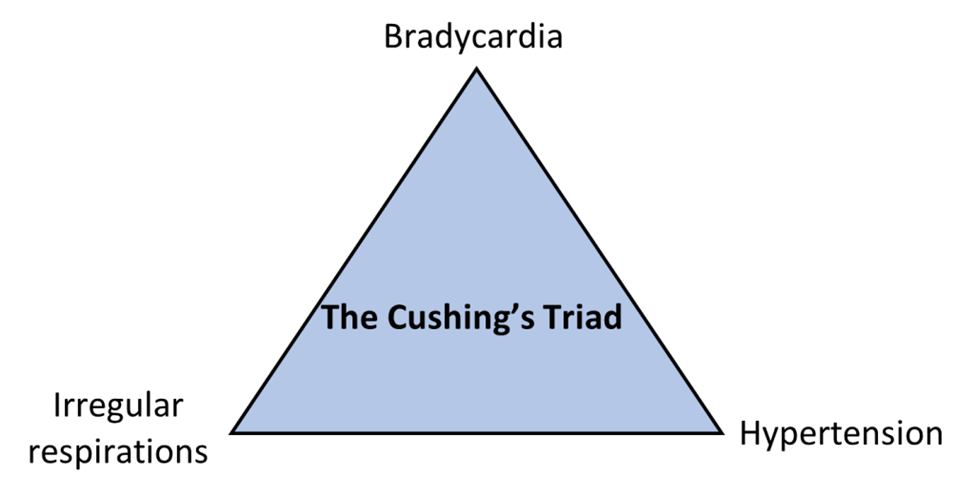Which three symptoms are characteristic of Cushing triad associated with increased ICP?
Bradycardia, hypertension, and widening pulse pressure
Widening pulse pressure, headache, and seizure
Hypertension, tachycardia, and headache
Hypotension, tachycardia, and narrowing pulse pressure
The Correct Answer is A
A. Bradycardia, hypertension, and widening pulse pressure
This combination of symptoms is characteristic of Cushing's triad. Bradycardia (slow heart rate), hypertension (elevated blood pressure), and widening pulse pressure (difference between systolic and diastolic blood pressure) are indicative of increased ICP, specifically resulting in the compression of brain structures that regulate vital functions.
B. Widening pulse pressure, headache, and seizure
While headache and seizure may occur in patients with increased ICP, widening pulse pressure alone is not sufficient to meet the criteria of Cushing's triad. The presence of bradycardia and hypertension, along with widening pulse pressure, is more indicative of Cushing's triad.
C. Hypertension, tachycardia, and headache
Hypertension and headache may occur in patients with increased ICP, but the absence of bradycardia and widening pulse pressure makes this option less characteristic of Cushing's triad.
D. Hypotension, tachycardia, and narrowing pulse pressure
Hypotension (low blood pressure) and narrowing pulse pressure are not typically associated with Cushing's triad. Tachycardia (rapid heart rate) may occur in response to increased ICP, but it is usually accompanied by bradycardia rather than hypotension.

Nursing Test Bank
Naxlex Comprehensive Predictor Exams
Related Questions
Correct Answer is A
Explanation
A. Toes turning up and spreading:
This description corresponds to the abnormal finding in the Babinski reflex. In a positive Babinski sign, the big toe (hallux) dorsiflexes (turns upward) and the other toes fan out. This response is abnormal in adults but normal in infants up to a certain age.
B. Downward curl of the toes:
This response is typical of the normal plantar reflex, where the toes curl downward (plantar flexion) in response to stimulation of the sole of the foot. It is not indicative of the Babinski reflex.
C. Pain in the big toe:
Pain in the big toe is not a characteristic finding of the Babinski reflex. The Babinski sign is assessed by observing the movement pattern of the toes in response to stimulation, rather than eliciting pain.
D. Big toe bending upward:
The big toe bending upward, or dorsiflexion of the big toe, is a specific component of the positive Babinski sign. However, it is typically accompanied by spreading of the other toes, which is the hallmark feature of the Babinski reflex.

Correct Answer is A
Explanation
A. "It is too early to tell. When the spinal shock subsides, we will know more."
This response is appropriate. Spinal shock can initially obscure the extent of neurological injury, and it may take time for the full extent of the injury to become apparent. By acknowledging this and suggesting that more information will be available once spinal shock subsides, the nurse provides a realistic perspective without prematurely predicting the outcome.
B. "You should talk to your physician about things of that nature."
This response may come across as dismissive or evasive. While it is true that the physician ultimately determines the patient's prognosis, the family may be seeking reassurance and guidance from the nurse as well.
C. "No. Significant recovery of function should occur in a few days."
This response is overly optimistic and potentially misleading. While some improvement may occur in the days following a spinal cord injury, significant recovery of function within a few days is unlikely, especially in cases of flaccid paralysis of all extremities.
D. "Yes. In all likelihood, the paralysis is probably permanent."
This response is overly pessimistic and lacks sensitivity. It may unnecessarily distress the family and extinguish hope for the patient's recovery.
Whether you are a student looking to ace your exams or a practicing nurse seeking to enhance your expertise , our nursing education contents will empower you with the confidence and competence to make a difference in the lives of patients and become a respected leader in the healthcare field.
Visit Naxlex, invest in your future and unlock endless possibilities with our unparalleled nursing education contents today
Report Wrong Answer on the Current Question
Do you disagree with the answer? If yes, what is your expected answer? Explain.
Kindly be descriptive with the issue you are facing.
